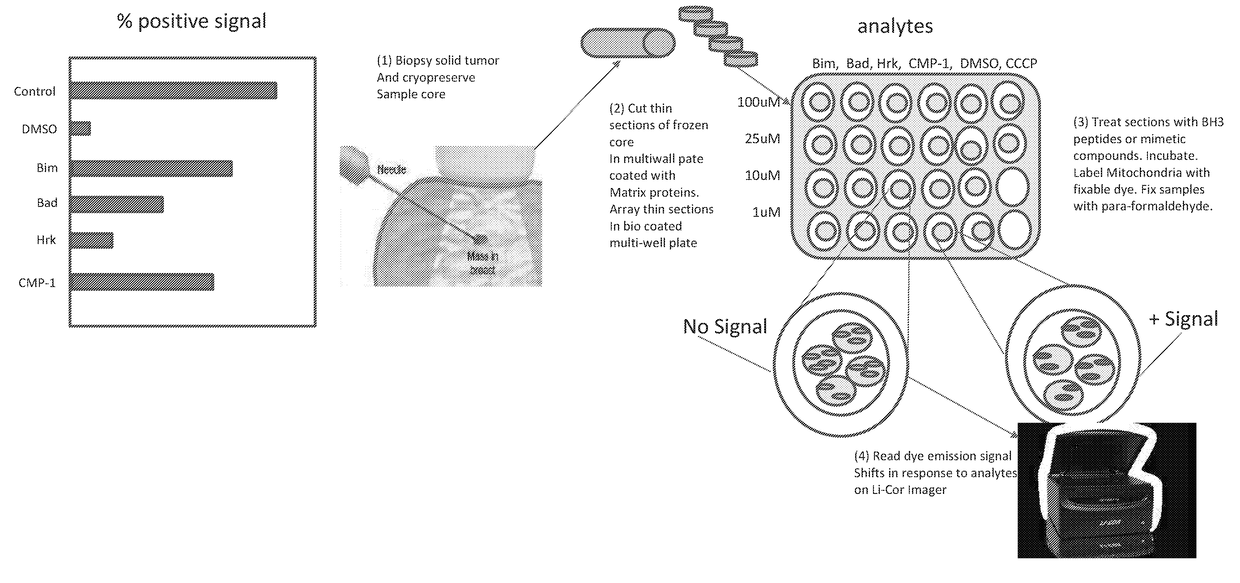Surrogate functional biomarker for solid tumor cancer
a functional biomarker and tumor technology, applied in the field of tumor tumor tumor tumor tumor surrogacy, can solve the problems of poor treatment effect, largely ineffective chemotherapy, and difficulty in determining how a drug will work in a patient, and achieve the effect of increasing the sensitivity and/or specificity of the assay
- Summary
- Abstract
- Description
- Claims
- Application Information
AI Technical Summary
Benefits of technology
Problems solved by technology
Method used
Image
Examples
example 1
Mitochondrial Profiling in Samples Taken from Solid Tumor Oncology Patient-Based Cohorts
[0126]Briefly, in this assay, the tumor specimen is prepared, subjected to various BH3 peptides, or BH3 mimetic compounds and the mitochondria stained with a fixable dye that fluoresces upon oxidation (indicating an increase in MOMP). Detection of the fluorescent signal (through fluorescent microscopy or LICOR imaging) detects whether MOMP has occurred. The percent of mitochondrial priming is determined via the equation disclosed herein. Multivariate analysis, taking into account the percent mitochondrial priming with and without other clinical or pathological factors, is used to predict the efficacy of one or more cancer treatments in the patient.
[0127]In addition to testing the tumor specimen, the following controls are used: 1) DMSO only—in place of a BH3 peptide and / or mimetics, and 2) carbonyl cyanide m-chlorophenylhydrazone (CCCP) for an apoptosis positive control (these cells will be MitoT...
example 2
Detection of Bcl-2 Heterodimers in Solid Minor Cells Using an Antibody
[0136]In addition to detecting MOMP in a sample to elucidate which Bcl-2 heterodimers play a role in the apoptotic state of the cancer, these heterodimers may be directly detected in a cancer sample. Here, an antibody that binds to a particular Bcl-2 heterodimer is applied to the sample, and then detected through immunofluorescence.
[0137]Antibodies have been developed that specifically bind to Bcl-2 heterodimers (see, for example, U.S. Pat. No. 8,168,755). These antibodies detect different Bcl-2 heterodimers present in a particular cancer, thereby informing the clinician of which BH3 peptides are influencing apoptosis in a particular cancer cell. This information can be used to help direct treatment and clinical decisions. The results from the mitochondrial profiling described in Example 1 can be compared with the results of antibody based heterodimer detection in samples taken from the same tumor and / or patient t...
example 3
Detection of Bcl-2 Heterodimers in Breast Cancer Cells Using an Antibody
[0142]FIG. 2 shows the percent heterodimer specific signal of breast cancer cells using a LI-COR imager. ABT-263 is a pro-apoptotic compound that can be used on whole cells to disrupt BH3 mediated interactions. Disruption of these heterodimers in treated cells is detected as loss of ANTI-HSBXB signal. Here the cells were treated with various concentrations of ABT-263 for 10 hours at 37° C., then rinsed, fixed with 4% PFA, and incubated with ANTI-HSBXB (a Bcl-xL / Bim heterodimer-specific antibody). IRDye 800CW goat anti-mouse antibody was used to detect the heterodimer specific mouse monoclonal antibody, and IRDye 800CW Goat anti-rabbit antibody was used to detect a commercial Bcl-xL rabbit monoclonal antibody. Cell numbers were normalized by using CellTag 700 Stain. We have determined a time window of 10-12 hours where the disruption by ABT-263 can be detected prior to caspase mediated membrane disruption of SKBR...
PUM
| Property | Measurement | Unit |
|---|---|---|
| wavelengths | aaaaa | aaaaa |
| time | aaaaa | aaaaa |
| mitochondrial membrane potential | aaaaa | aaaaa |
Abstract
Description
Claims
Application Information
 Login to View More
Login to View More - R&D
- Intellectual Property
- Life Sciences
- Materials
- Tech Scout
- Unparalleled Data Quality
- Higher Quality Content
- 60% Fewer Hallucinations
Browse by: Latest US Patents, China's latest patents, Technical Efficacy Thesaurus, Application Domain, Technology Topic, Popular Technical Reports.
© 2025 PatSnap. All rights reserved.Legal|Privacy policy|Modern Slavery Act Transparency Statement|Sitemap|About US| Contact US: help@patsnap.com



